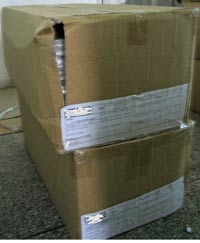
The export cartons are the cartons handled during transport to the importing country. Many importers leave the cartons’ specifications up to the supplier’s choice, but in Asia this can be a big mistake.
Properly-designed export cartons ensure that the products, but also the “inner packing” (which is often used on the point of purchase), are protected. A poor outer packaging can turn perfectly good products into unsellable items.
So this is a very important point to check, for 98% of QC inspections performed on consumer goods. Exceptions are products that are either shipped in bulk or shipped with another form of packing.
Recently I found some very interesting information on this issue, and I am going to reproduce it below.
First, what conditions are export cartons often exposed to?
In The Importance Of Packaging (an article from a Pro QC Int’l newsletter), an expert explains why export cartons’s strength and construction should be studied carefully:
Frank Ruotolo, an experienced packaging engineer, explains that “the most important consideration is the shipping environment for that product.” He adds that “you need to know how the pack will be stacked and handled throughout the entire distribution cycle. The environmental conditions that the pack will be exposed to are also extremely important. For instance, a carton will lose half of its stacking strength in one week in a high humidity environment. Imagine what happens to the carton strength of a product that spends six weeks on a container ship from Asia the United States!”Not understanding the shipping environment is the most common mistake that Frank sees in applications . One example he notes is the failure to recognize how the cartons will be stored in the shipping container or trailer, which affects the carton’s integrity. Orientation is an important consideration because the carton itself only has stacking strength in one direction, which is why it is imperative that the pack be designed the way it will be stacked in transit.Frank recommends that master cartons be corrugated RSC (regular slotted containers). “The corrugation of the carton should run vertically when in its intended shipping/stacking orientation. The board strength of the carton should be adequate for the size of the carton, the weight of the product and the shipping environment.” He also adds that for “international shipments, the long shipping time in a high-humidity environment is not always factored into the corrugated board’s strength selection. The carton’s compression strength will be severely decreased by the time it arrives at its destination. It then still has to go through the remainder of the distribution cycle in this weakened state.”
These are very good points. Export cartons have to be able to withstand several shipments. In many cases, this is what happens to them:
- They are shipped from China to the destination country, which means at least on loading and one unloading (and more for LCL shipments),
- They are stored in a warehouse for up to a few years,
- They are loaded again on a truck or on pallets, and delivered to the store.
Second, what are the main points to specify and to check on export cartons?
In Retail Packaging Check – Verifying your China goods pre-shipment, Andrew Reich makes a list of the usual checkpoints regarding packaging. It focuses on the export carton and the other packing elements (gift box, polybag, etc.). If you have to specify what you require in terms of packaging, make sure you read this post.
Third, aren’t there industry standards?
Some standards are widely used. For example, the ISTA 1A for the carton-drop test (designed to check the resistance of boxes). I have proposed it to several clients, and I got very diverse reactions.
- A Swiss mail-order company told me it was really too tough on the products, so we settled for an easier test. I remember we were preparing an inspection of glass products, so I can understand their reaction.
- Conversely, a Canadian wholesaler told me their standard was tougher than the ISTA 1A, simply because of their customers’ high requirements. The export cartons had to be brought to several distribution centers, and from there the inner cartons were shipped to individual stores.
To sum up, I will say these consideration depend both on the type of product and on the distribution channel… There is no one-size-fits-all solution!
No comments:
Post a Comment